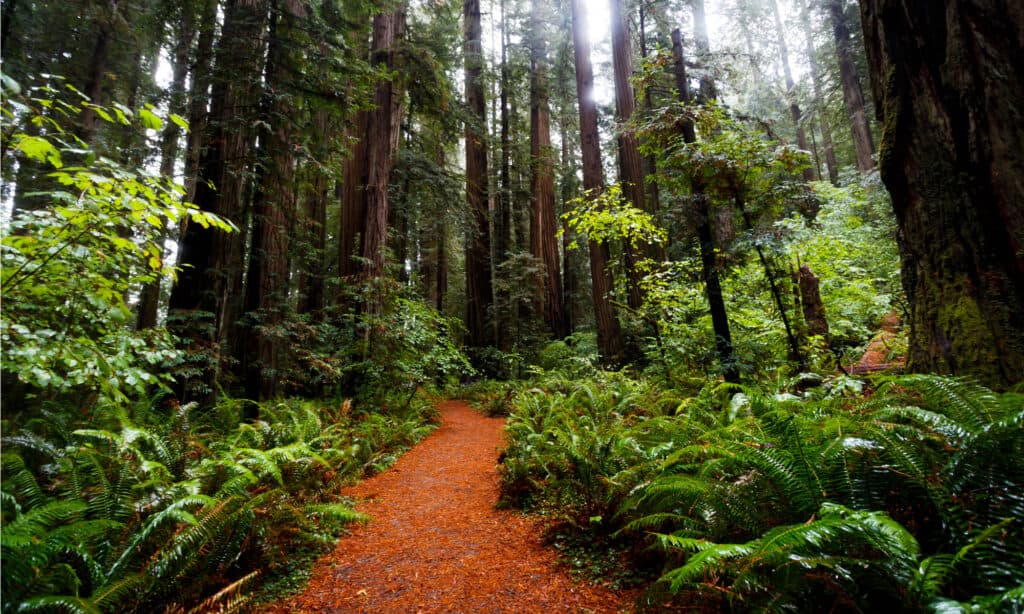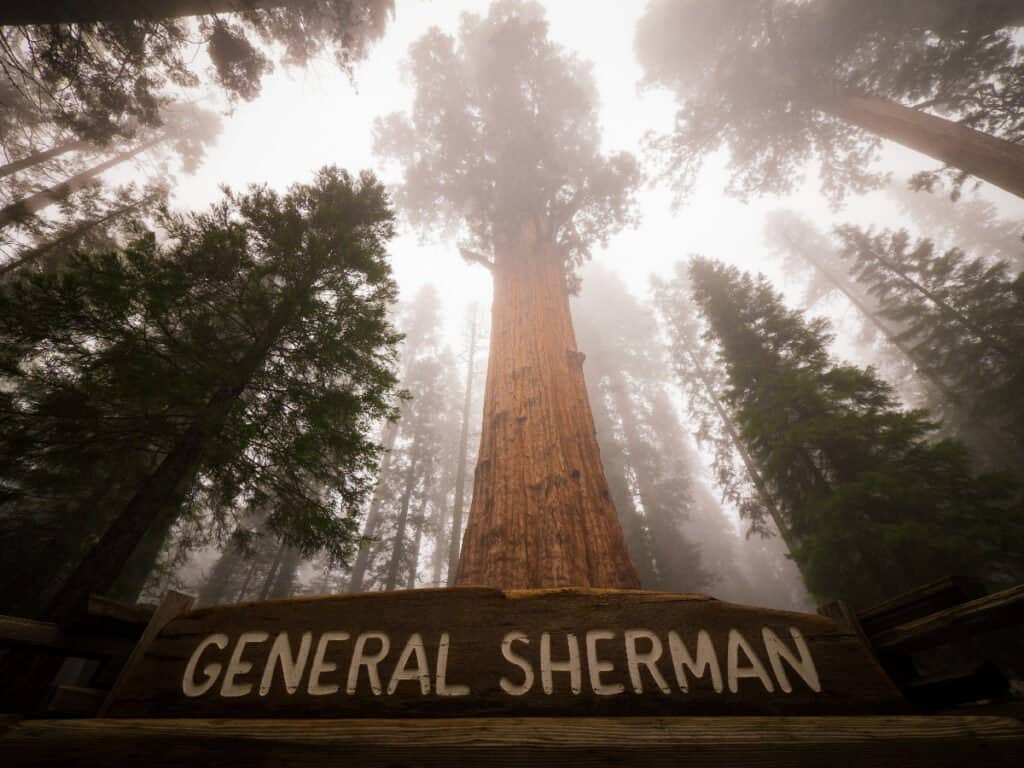Redwood trees, often referred to as redwoods, are part of the Sequoioideae subfamily (of the Cupressaceae family). This family is well-known among nature enthusiasts, as it includes the tallest and largest trees in the world.
However, it is worth mentioning that the subfamily known as redwoods actually includes three genera. As such, it goes without saying that tree heights will be variable. This is exactly what we’ll tackle in today’s article – how tall are all types of redwood trees?
Stay tuned until the end of the article, as we’ll answer some of the most asked questions regarding redwoods!
Redwood Classification – The Sequoioideae Subfamily

The
redwoodsubfamily consists of three genera –
Sequoia, Sequoiadendron, and Metasequoia.
©The Migrating Monkey/Shutterstock.com
As mentioned, the redwood subfamily consists of three genera – Sequoia, Sequoiadendron, and Metasequoia. The species in the first genus can be found in Oregon and California, the second in the Sierra Nevada only, and the third is native to China.
In short, the three genera mentioned include all the redwoods in the world. These trees are known for being able to live for thousands of years. The downside is that multiple modern aspects, such as climate change, burl poaching, and illegal marijuana cultivation, predominantly threaten their existence.
The Sequoia genus
This genus consists of eight species of coniferous redwood trees. Of these, the only living species is Sequoia sempervirens, which is predominantly spread throughout the coastal forest ecoregion of Northern California. This redwood genus includes the heaviest and tallest trees in the world.
The Sequoiadendron genus
This genus consists of two species of redwood evergreen trees. Out of the two, only the Sequoiadendron giganteum species is alive and well today. The latter species is often referred to as giant sequoia, giant redwood, or Wellingtonia.
As you probably already know, giant sequoia trees can be found in California’s Sierra Nevada – a location famous for its dense sequoia forests.
The Metasequoia genus
This genus consists of five species of fast-growing redwood deciduous trees. Out of the five, only one survived to this day, the Metasequoia glyptostroboides. Metasequoia specimens are often referred to as “dawn redwoods.”
Specimens of the surviving species are native to Lichuan County (China, Hubei province). They are the shortest redwood specimens in the Sequoioideae subfamily, growing to about 165 feet high.
How Tall Is an Average Redwood?
Since there are three species spread across three genera, it is clear that there are differences between each average specimen. To exemplify this, we’ve prepared a simple table for you to peruse.
| Average height | Average lifespan | |
|---|---|---|
| Sequoia sempervirens | 200 to 325 feet | 1,200 to 2,200 years |
| Sequoiadendron giganteum | 164 to 279 feet | 2000 to 3000 years |
| Metasequoia glyptostroboides | 88.5 feet | Over 100 years |
We included the average lifespan section to emphasize the sheer greatness redwoods possess. A single specimen can live up to thousands of years (best case scenario) on our planet. That’s something simply beyond amazing!
Which Is Bigger: Sequoia or Redwood?

Sequoia is a redwood tree species.
©daveynin / flickr – License
This is a trick question. Sequoia is a redwood tree species, so their height can’t be compared. However, the well-known sequoia tree (Sequoia sempervirens) is the tallest when considering the other species in the same subfamily. But the question mentions bigger, right?
Well, if we are to dissect this topic, then we can talk about the tallest tree in the world, as well as about the biggest (in terms of trunk volume), the stoutest (in terms of trunk girth), the broadest (in terms of the crown), the thickest tree limbs, and the thickest tree bark. As you can see, plenty of aspects can make a tree big, not only height.
Specimens of the Sequoioideae subfamily dominate four of the mentioned aspects – the giant sequoia has the thickest tree bark, as well as the thickest tree limbs and the biggest trunk volume, while the coast redwood (Sequoia sempervirens) is the tallest tree in the world.
How Tall Is the Tallest Sequoia Tree?

The tallest sequoia tree in the world is named
Hyperion.
©Stephen Moehle/Shutterstock.com
The tallest sequoia tree in the world is named Hyperion and stands at a height of 380.3 feet. It watches over Redwood National Park in California, United States. Certain sources might point to General Sherman as the tallest tree; however, it is the largest by trunk volume.
The second-tallest tree in the world is a specimen of the Eucalyptus regnans (Mountain ash) species named Centurion. It stands at a height of 330 feet.
What’s the Largest Tree in the World?

The largest tree in the world is named “
General Sherman.”
©zdenekkounovsky/Shutterstock.com
The largest tree in the world is named “General Sherman,” which has a trunk volume of 52,500 cubic feet. Its trunk has a circumference at the ground of 102.6 feet. The tree is only 274.9 feet tall- about 100 feet shorter than the tallest tree in the world, Hyperion.
The second-largest tree in the world by trunk volume is a specimen of Sequoia sempervirens named Grogan’s Fault. It has a trunk volume of 38,300 cubic feet.
Interesting Facts About Redwood Trees
Here are a couple of interesting facts about redwood trees that you can think about while exploring the Sierra Nevada or a sequoia forest:
- A species of endangered birds, the marbled murrelets, lays its eggs on the upper branches of redwood trees – at over 300 feet high if we’re talking about the largest redwood trees;
- Redwood canopies are incredibly vibrant and full of life. Species such as the wandering salamander can live their entire lives in redwoods;
- As redwoods can live hundreds, even thousands of years, other plants and even small trees can eventually develop and grow on their branches or spur out of the trunk;
- The leaves of redwood trees pull in and store more carbon than any other tree in the world. They are the ultimate air cleaners;
- Redwood trees are resistant to fire and rot. As a result, it makes no sense to cut down a specimen just because it is old;
- Protection from rot, fire, and bugs is ensured via the one-foot thick bark redwood trees have;
- Some of the oldest redwood tree fossils date back to the Jurassic age when dinosaurs still roamed the Earth.
That was it! You now know how tall redwood trees are on average and which species hold records around the world for being the largest and tallest.
Up Next:
- The Largest Trees in California
- Dawn Redwood vs. Bald Cypress: 5 Key Differences
- Giant Sequoia vs. Coast Redwood: What’s the Difference?
The photo featured at the top of this post is © Ryan Kelehar/Shutterstock.com
Sources
- Sempervirens Fund, Available here: https://sempervirens.org/learn/redwood-facts/
Thank you for reading! Have some feedback for us? Contact the AZ Animals editorial team.







